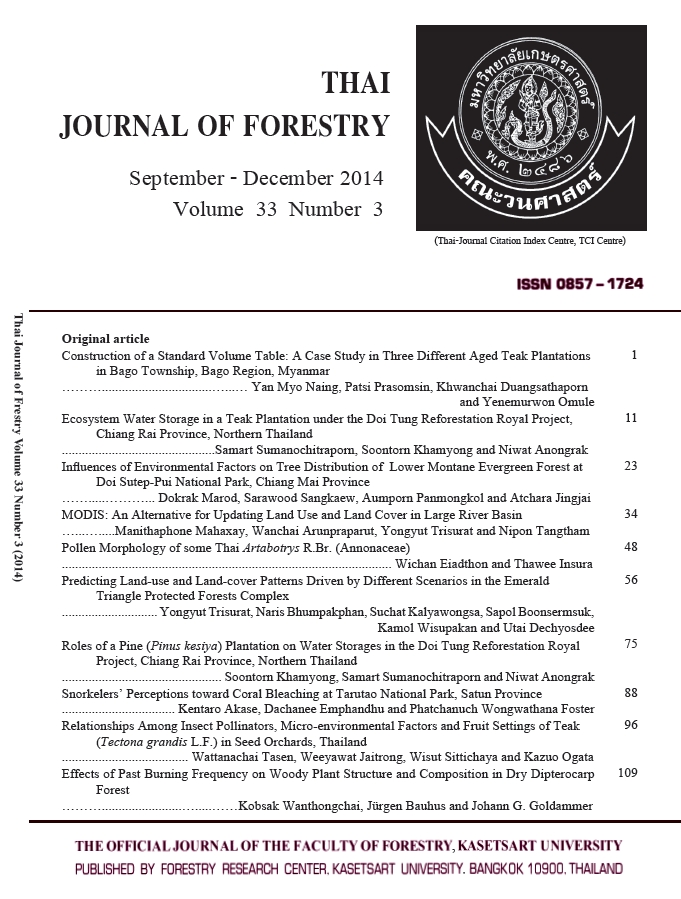Predicting Land-use and Land-cover Patterns Driven by Different Scenarios in the Emerald Triangle Protected Forests Complex
Main Article Content
บทคัดย่อ
The Emerald Triangle is the largest extensive intact block in the Greater Mekong Sub-region, which still remains along the tri-national borders between Thailand, Lao PDR and Cambodia. The remaining habitats are very important for the persistence of wide-ranging species in this area. This research aimed to assess land-use change in recent years and to predict land-use patterns across the Emerald Triangle landscape. The current land-use map was visually interpreted from satellite images and the rate of reduction was calculated accordingly. Future land-use patterns were predicted using the Dyna-CLUE model based on different land-use scenarios in 2030 defined by multi-stakeholders from the three countries. The model results indicated that dry dipterocarp forest in the north of Dong Khanthung provincial protected forest in Lao PDR and to the west of Pha Taem National Park in Thailand would be threatened by encroachment for agriculture and rubber plantation. If on restriction policy, parts of the Preah Vihear protected forest in Cambodia and Phou Xiang Thong National Biodiversity Conservation Area in Lao PDR would be converted for arable land in 2030. Evergreen forests were predicted as relatively intact as the current stage because they are found either inside protected areas or in steep terrains, thus become natural barriers for human-intervention.
Keywords: CLUE-s model, Emerald Triangle, Land use scenarios, Trans-boundary biodiversity conservation
Downloads
Article Details

อนุญาตภายใต้เงื่อนไข Creative Commons Attribution-NonCommercial-NoDerivatives 4.0 International License.
ข้าพเจ้าและผู้เขียนร่วม (ถ้ามี) ขอรับรองว่า ต้นฉบับที่เสนอมานี้ยังไม่เคยได้รับการตีพิมพ์และไม่ได้อยู่ในระหว่างกระบวนการพิจารณาตีพิมพ์ลงในวารสารหรือสิ่งตีพิมพ์อื่นใด ข้าพเจ้าและผู้เขียนร่วม (ถ้ามี) ยอมรับหลักเกณฑ์และเงื่อนไขการพิจารณาต้นฉบับ ทั้งยินยอมให้กองบรรณาธิการมีสิทธิ์พิจารณาและตรวจแก้ต้นฉบับได้ตามที่เห็นสมควร พร้อมนี้ขอมอบลิขสิทธิ์ผลงานที่ได้รับการตีพิมพ์ให้แก่วารสารวนศาสตร์ คณะวนศาสตร์ มหาวิทยาลัยเกษตรศาสตร์ กรณีมีการฟ้องร้องเรื่องการละเมิดลิขสิทธิ์เกี่ยวกับภาพ กราฟ ข้อความส่วนใดส่วนหนึ่ง หรือ ข้อคิดเห็นที่ปรากฏในผลงาน ให้เป็นความรับผิดชอบของข้าพเจ้าและผู้เขียนร่วม (ถ้ามี) แต่เพียงฝ่ายเดียว และหากข้าพเจ้าและผู้เขียนร่วม (ถ้ามี) ประสงค์ถอนบทความในระหว่างกระบวนการพิจารณาของทางวารสาร ข้าพเจ้าและผู้เขียนร่วม (ถ้ามี) ยินดีรับผิดชอบค่าใช้จ่ายทั้งหมดที่เกิดขึ้นในกระบวนการพิจารณาบทความนั้น”


